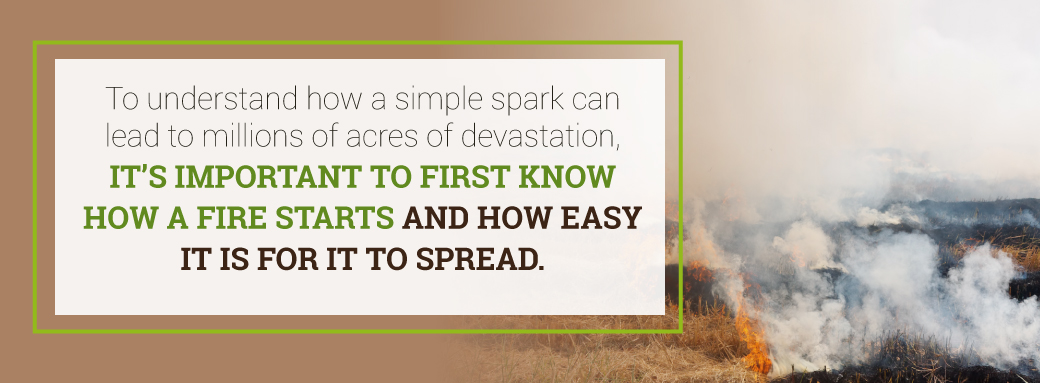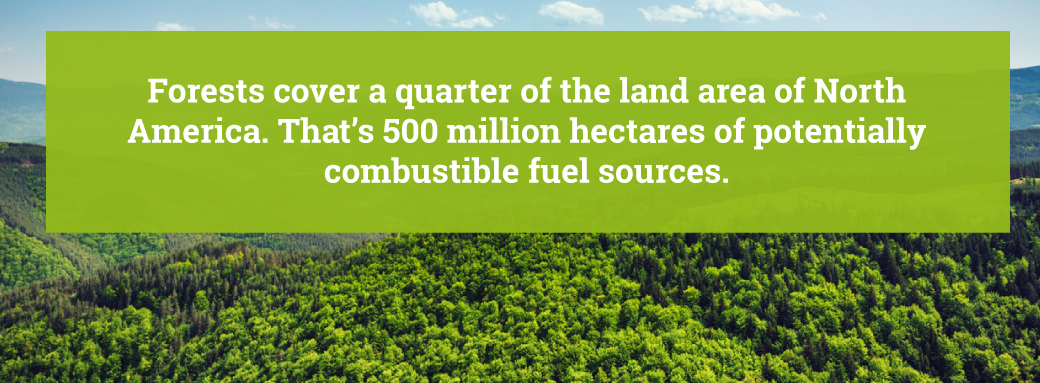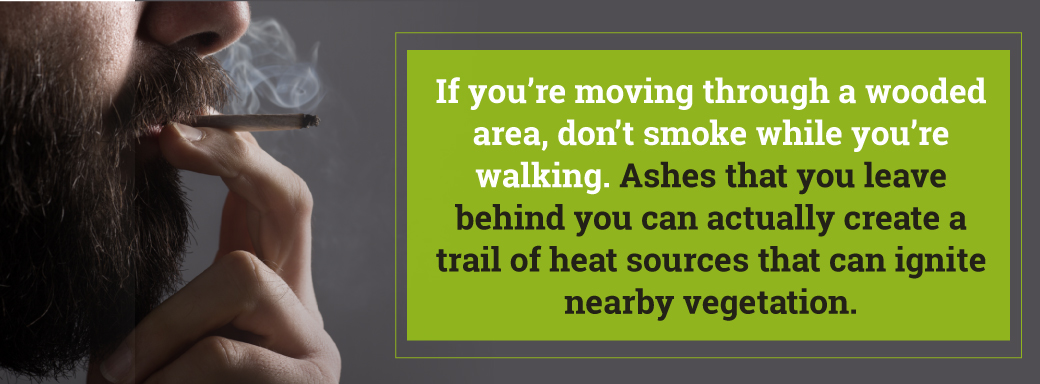
How to Prevent Forest Fires
- How Do Forest Fires Occur?
- Where Do Most Forest Fires Occur?
- What Role Do People Play in Forest Fires?
- 10 Ways You Can Help Prevent Forest Fires
Forest fires are unplanned, accidental fires that start in forests or vegetative areas. Sometimes, forest fires are also called wildfires, bushfires, grass fires and wildland fires, among other names. But they all refer to the phenomenon of uncontrolled fire that spreads and destroys everything in its path, sometimes including entire communities.
In many areas across North America, forest fires have become so common that many officials now consider them the new normal. But they don’t have to be. Humans cause the majority of forest fires. This means that humans can also play a significant role in the prevention of wildfires and the ongoing protection and preservation of our valuable forests. That’s why it’s critical for all Virginians who enjoy time in the woods to know exactly what their potential role is in human-caused forest fires. They must also be aware of what their responsibilities are in preventing wildfires in Virginia and the steps they can take to mitigate fire risk.
How Do Forest Fires Occur?
At a broad level, forest fires occur for many reasons. There are two main classifications for forest fire causes: human-caused and nature-caused. To understand how a simple spark can lead to millions of acres of devastation, it’s important to first know how a fire starts and how easy it is for it to spread.

Fire needs three ingredients to start: fuel, heat and oxygen. Forests can contain all of these components, which makes them the perfect platform for igniting a fire. The first ingredient, fuel, is omnipresent in forests. Forests are full of biomass fuel that can cause fires to start almost effortlessly. Forests harbor dried, decaying wood, leaves and other natural combustibles. In fact, the entire forest floor is a giant offering of fuel to start a forest fire. This is especially true during the summer when dead vegetation has fully dried out and can reach high temperatures if there is a high enough source of heat.
That brings us to the second ingredient required to start a forest fire, which is the heat source. This is what determines whether Mother Nature causes the forest fire, or humans do. A heat source can come from the high temperatures of the sun during long summer days. Lightning strikes can also provide a heat source to spark a fire. Sadly, humans also knowingly or neglectfully provide heat sources through things like cigarettes or campfires.
The third ingredient is oxygen. Trees are photosynthesizing lifeforms and are constantly creating fresh oxygen. This makes a forest full of the oxygen required to start a fire. When combustibles like wood or leaves heat up from the sun or another heat source, they can reach extremely high temperatures. If they reach a certain temperature, they start to emit steam. This steam can then naturally react with the oxygen in the air, which can cause a burst of flame.
This burst of flame then acts as a heat source for other surrounding combustibles. As these fuel sources heat up, they too can ignite into flame, which heats up more neighboring combustibles. Left uncontrolled, flames will continue to spread via a destructive chain reaction process. Eventually, it results in powerful forest fires that destroy everything in their path, including any living beings that can’t get away in time. This is why forest fires can prompt an emergency evacuation of thousands of surrounding inhabitants.
Where Do Most Forest Fires Occur?
Forest fires are a highly powerful force throughout the world. Many areas of the planet are prone to wildfire devastation including Australia, southern Africa and North America. These regions, in particular, have all the right criteria to start forest fires, including the dry weather conditions and the dense vegetation.

If we look at North America’s biological composition, it’s no wonder forest fires are so common on this continent. Forests cover a quarter of the land area of North America. That’s 500 million hectares of potentially combustible fuel sources. Though forest fires can happen virtually anywhere, certain areas throughout North America are more susceptible to frequent wildfire devastation due to their biological composition.
The United States Geological Survey collected data on forest fires between 1994-2013 to monitor the frequency and size of wildfires throughout the United States. According to their classifications, the USGS considers a large forest fire to be one that spreads over 300 acres. They consider a high frequency to be between 101 and 1,308 fires during that 19-year period. Based on this research by the USGS, here are where most major forest fires occur:
- Western United States: The western states are the most vulnerable and susceptible to wildfires due to the general climate and geography. Every western state, except for Wyoming has at least one county categorized as having a high frequency rate of forest fires.
- Plains and Southern States: The data from the USGS on forest fire rates also showed that forest fires have deeply impacted the Plains and many southern states. Florida, Louisiana, Texas, Oklahoma and South Dakota all had at least one county that fell into the high forest fire frequency range.
- Alaska: While it may not seem obvious, Alaska actually has one of the highest rates of wildfire in the United States. The weather in Alaska gets hot and dry in the summer. As a result, multiple counties in Central Alaska have high frequencies of wildfires. Hundreds of thousands of acres are destroyed every year in Central Alaska due to forest fires.
It’s important to keep in mind that these are only areas that have multiple, large forest fires. Any forested area is at-risk of fire, given the right combination of heat and fuel sources. This includes forests in Virginia. When our weather heats up and relative humidity level drops, it can create an ideal environment for wildfire starts. This means that during the summer and fall months, Virginia residents need to be extremely cautious and aware of the role that people play in forest fire starts.
What Role Do People Play in Forest Fires?
People account for the vast majority of forest fires started throughout North America. While lightning strikes are the greatest natural cause of forest fires, the number of individual forest fires started by humans far exceeds the number of fires started by lightning. Interestingly, lightning-caused forest fires are actually more destructive in terms of the total area they destroy. This is because lightning-started fires typically begin in isolated locations, which makes it difficult if not impossible for firefighters to control.

A 10-year average of US forest fires indicates that lightning-started fires burned 2.1 million acres, and human-started fires burned 1.9 million acres. Despite the potentially less destructive nature of human-started forest fires, they’re still far too prevalent. Researchers say that there are almost 10 times more human-caused forest fires than lightning-caused forest fires. During a 10-year average, 88% of US forest fires are human-caused, while the remaining 12% are lightning-caused.
The majority of the human-caused forest fires in these statistics are accidental. Human-started forest fires are usually attributed to backwoods explorers, campers and hikers who were careless with their campfires or cigarettes. In many of these cases, people genuinely thought their heat source was fully extinguished. They may have thought they put out their cigarette or campfire completely. Then after walking away, the element is still hot and causes nearby combustibles to light up.
In other cases, wildfires start when people go into the woods to burn garbage, and the flames get away on them. This is less common, but it has been known to happen. In even rarer, but tragic cases, forest fires are intentionally started by arsonists.
In Virginia, 96% of forest fires are caused by humans. Often, this will happen when people think that it’s not hot and dry enough for forest fires to start. Forest fires have been known to happen in fall and winter months, so it’s critical to be aware of the potential for combustion at all times. Virginia has a fall forest fire season that runs from October 15 through November 30 each year. All residents must take extreme precautions if burning during these weeks so that they can actively prevent forest fires in Virginia.
10 Ways You Can Help Prevent Forest Fires
When you look at the devastation caused by human-started forest fires, it’s important to imagine how huge of a role prevention plays. If everyone took the necessary steps to prevent wildfires in Virginia, the rates of devastation would drop significantly.
It’s vital for all people to take responsibility for preventing wildfires in Virginia and all across the continent. Forests can take dozens if not hundreds of years to recover from the damage done by fires. These aren’t losses we want to face when you consider the critical ecological role that forests play.
If you’re interested in learning more about preventing forest fires in Virginia, then it’s important to look at your own actions and those of your family. Everyone wants to enjoy the outdoors, but it’s necessary to do so mindfully and responsibly. Here are some tips on how to prevent forest fires and what you need to know to change your outdoor habits:
- Never Leave a Fire Unattended: This is the most important rule when it comes to preventing forest fires. If you’ve started a campfire, bonfire or burn pile, someone must monitor the fire at all times. Fire is a powerful force, and as such, it can be totally unpredictable. Sparks can hop from a burn pile and into a load of dried, combustible fuel, igniting a new fire in no time.
- Be Cautious with Heat and Fire: If you have a fire going, it’s important to be cautious handling the fire. If you’re using a stick or poker to move the combustibles around, do so cautiously. Be sure to only use natural vegetation in a campfire. Using treated wood products can result in chemical combustion, which is dangerous and toxic. Likewise, never burn trash such as plastic wrappers or Styrofoam in your campfire. Only use natural materials.
- Factor in the Wind: Many forest fires could have been prevented had the people starting the fires known how much wind plays a factor in the spreading of flames. If you’re experiencing strong winds, you might want to wait to start your fire another time. Winds can blow hot combustibles around, which can act as the heat source for nearby brush and vegetation. You’ll know it’s too windy for a fire if you see tree branches swaying or waves on the water.
- Have a Fire Extinguishing Solution: In many cases, wildfires could have been prevented had there only been a fire extinguishing solution available in time. If you’re lighting a campfire or doing a burn, make sure to have a fire extinguisher or a full 5-gallon bucket of water available. If possible, have a connected hose at the ready. This way, you’ll instantly have a solution should flames get out of control.
- Attend The Fire Until It’s Fully Out: Never assume “good enough.” It’s critical to stay with the fire and watch it until you know for sure it’s completely extinguished. Remember that all that’s needed for a fire to start is a heat source near vegetation. If the fire remains hot, it can still ignite nearby dried leaves or wood.
- Use No-Burn Options: While you can’t argue the beauty of a natural campfire, protecting our forests is still more important. Consider using no-burn options like battery-powered candles and other flameless products. Because of the increased awareness around forest fire prevention, these types of no-burn solutions are becoming more popular.
- Be a Responsible Smoker: If you’re moving through a wooded area, don’t smoke while you’re walking. Ashes that you leave behind you can actually create a trail of heat sources that can ignite nearby vegetation. When you do smoke outside, be sure to fully extinguish your cigarette butt and take it with you. Do not let it sit on the forest floor.
- Know Your Local Regulations: Always follow your local regulations regarding burning and campfires. Each community will have its own campfire bans or restrictions as well as permits for burn piles. These regulations are in place as a means of preventing forest fires in Virginia. That’s because local experts know the exact wildfire risk level at all times and implement regulations accordingly.
- Clear Your Burn Pile Area: If you’re starting a burn pile after receiving the appropriate permits, then be sure to manage the fire responsibly. This means clearing a wide area around your burn pile before igniting the fire. Remove any potentially combustible debris such as piles of leaves, grass, wood or other dried out materials.
- Call 9-11: If a fire has gotten out of control, you must call the emergency services immediately. This includes 9-11 or other local emergency contacts. You can still do whatever you can to control and extinguish the fire using water or sand. But if a fire has become uncontrollable then firefighters need to intervene.
There’s a reason Smokey the Bear has been such a prominent, cultural icon over the past several decades. That’s because he’s right when he says, "Only you can prevent forest fires." Because humans are the leading cause of forest fires, they can also be the leading preventers of them. It’s important for each of us to respect Mother Nature for her beauty and her power. If we want to continue to enjoy forests and the serenity of being in the woods, then we must be respectful and conscientious of our actions.

Our forests deserve protecting and preservation, and we are the ones who can make that happen. For more information on trees and what you can do to care for them in Virginia, browse through our website resources.
If it is an emergency please call us immediately at 703-354-3667.
Use this form to schedule a FREE estimate. After submitting your form, our team will contact you to set up this appointment.
